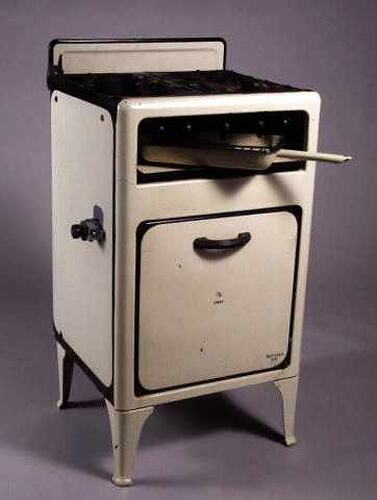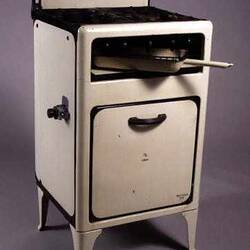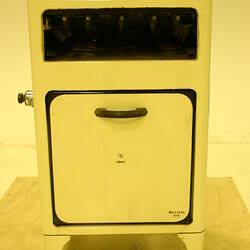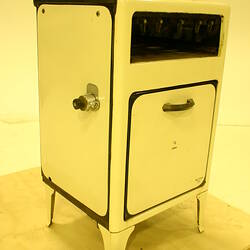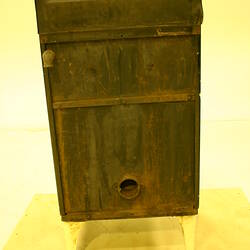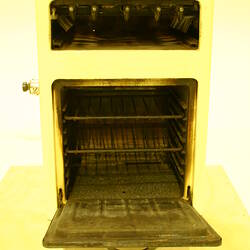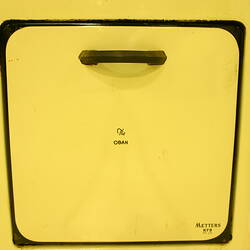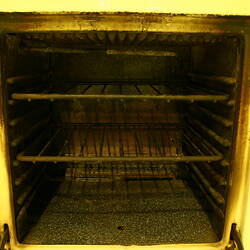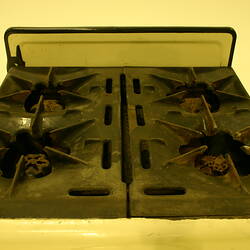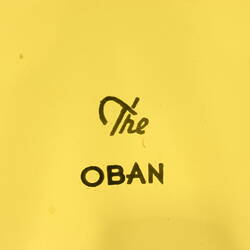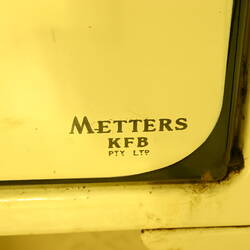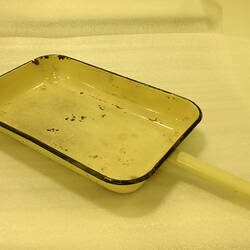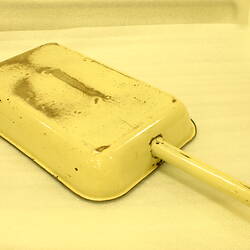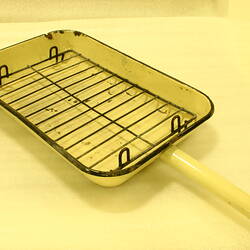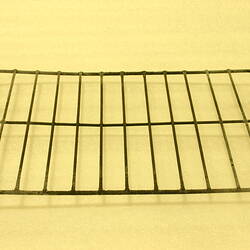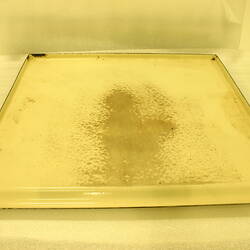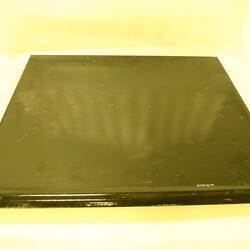Summary
Gas, Metters KFB, Oban, cream stove. The upright stove is enamelled in cream with black trim, and sits on 4 short legs. It was made by Metters KFB Pty Ltd, circa 1951, and was used in Mitcham, Victoria, Australia. The stove was purchased new by the donor and his wife just after they married. It was converted to natural gas; at the time of conversion the burner surrounds cracked where the installers broke them.
Access to power supplies impacted significantly upon the market for gas and electric stoves. Though cooking in electric ovens was advertised from the outset as 'cleaner and more efficient', in the 1920s only 34% of all houses in Victoria were wired for electricity. Gas was available to many more Australian homes and consequently gas stoves, which were cheaper to purchase, cheaper to run, and required no installation fee, sold in greater numbers than electric stoves. In the early 1920s, electric stoves were being imported into Australia. High tariffs meant these stoves were incredibly expensive; coupled with installation and running costs, it is not surprising that in 1923, only 0.1% of the population owned an electric stove. Despite the fact that over 80% of homes in Australia were wired for electricity by 1947, an estimate of electric stove ownership for 1955 indicates take up to be low: 36% of homes in Brisbane, 25% in Sydney and 24% in Melbourne. (Dingle 1998)
Physical Description
An upright gas stove. Cream enamel with black enamel trim on 4 legs. TOP: 2 full length iron grills with 2 burners per grill and additional central burner. Cream with black trim splash back. FRONT: removable tray under burners. 5 black control dials across upper edge, linked to each burner unit. Far left silver metal, hinged lever. DOOR: cream with black trim. Stencilled middle with model and lower right with manufacturer. HANDLE - horizontal, black D-shape. INTERIOR: traces of mottled black enamel on door and back. Base mottled black enamel. 7 runners, with 2 removable wire shelves. Gas burner along width of base at rear. Left side, top, pipe runs 3/4 width of oven. Base, hole front centre. Top, solid metal with lines of regular "V" nodule decoration. SIDES: Left: middle right, oven control with black knob. BACK: black, large pipe mount lower left.
Significance
Solid fuel stoves continued to be manufactured for the Australian consumer throughout the early decades of the 20th century. In urban areas solid fuel was eventually replaced by gas or electricity.
Access to power supplies impacted significantly upon the market for gas and electric stoves. Though cooking in electric ovens was advertised from the outset as 'cleaner and more efficient', in the 1920s only 34% of all houses in Victoria were wired for electricity. Gas was available to many more Australian homes and consequently gas stoves, which were cheaper to purchase, cheaper to run, and required no installation fee, sold in greater numbers than electric stoves.
In the early 1920s, electric stoves were being imported into Australia. High tariffs meant these stoves were incredibly expensive; coupled with installation and running costs, it is not surprising that in 1923, only 0.1% of the population owned an electric stove. Despite the fact that over 80% of homes in Australia were wired for electricity by 1947, an estimate of electric stove ownership for 1955 indicates take up to be low: 36% of homes in Brisbane, 25% in Sydney and 24% in Melbourne. (Dingle 1998)
More Information
-
Collection Names
-
Collecting Areas
-
Acquisition Information
Donation from Mr Graham, 08 Aug 1994
-
Manufacturer
Metters - KFB Pty Ltd, 1951 or later
Purchase docket dated 7 Aug 1951. -
Place Used
-
Inscriptions
FRONT: on door at middle "The/OBAN"; lower right "METTERS/KFB/PTY/LTD" SIDE: on black knob "A POPE PRODUCT/AUSTRALIA"
-
Brand Names
-
Classification
-
Category
-
Discipline
-
Type of item
-
overall dimensions
54 cm (Length), 57.5 cm (Width), 102 cm (Height)
-
Keywords
